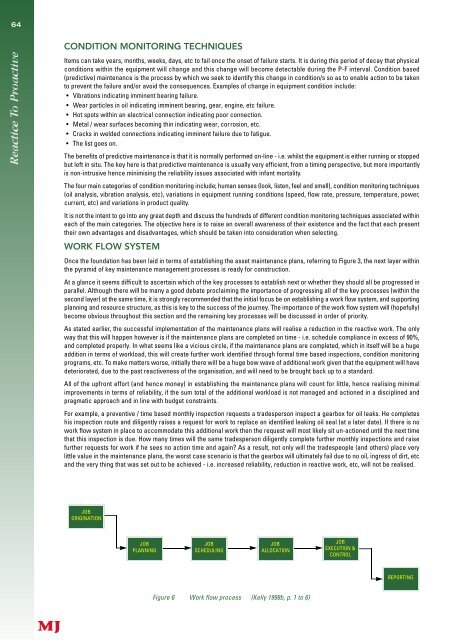October - Library - Central Queensland University
October - Library - Central Queensland University
October - Library - Central Queensland University
You also want an ePaper? Increase the reach of your titles
YUMPU automatically turns print PDFs into web optimized ePapers that Google loves.
64<br />
CONDITION MONITORING TECHNIQUES<br />
Items can take years, months, weeks, days, etc to fail once the onset of failure starts. It is during this period of decay that physical<br />
conditions within the equipment will change and this change will become detectable during the P-F interval. Condition based<br />
(predictive) maintenance is the process by which we seek to identify this change in condition/s so as to enable action to be taken<br />
to prevent the failure and/or avoid the consequences. Examples of change in equipment condition include:<br />
• Vibrations indicating imminent bearing failure.<br />
• Wear particles in oil indicating imminent bearing, gear, engine, etc failure.<br />
• Hot spots within an electrical connection indicating poor connection.<br />
• Metal / wear surfaces becoming thin indicating wear, corrosion, etc.<br />
• Cracks in welded connections indicating imminent failure due to fatigue.<br />
• The list goes on.<br />
The benefits of predictive maintenance is that it is normally perf o rmed on-line - i.e. whilst the equipment is either running or stopped<br />
but left in situ. The key here is that predictive maintenance is usually very efficient, from a timing perspective, but more importantly<br />
is non-intrusive hence minimising the reliability issues associated with infant mortality.<br />
The four main categories of condition monitoring include; human senses (look, listen, feel and smell), condition monitoring techniques<br />
(oil analysis, vibration analysis, etc), variations in equipment running conditions (speed, flow rate, pre s s u re, temperature, power,<br />
current, etc) and variations in product quality.<br />
It is not the intent to go into any great depth and discuss the hundreds of diff e rent condition monitoring techniques associated within<br />
each of the main categories. The objective here is to raise an overall awareness of their existence and the fact that each present<br />
their own advantages and disadvantages, which should be taken into consideration when selecting.<br />
WORK FLOW SYSTEM<br />
Once the foundation has been laid in terms of establishing the asset maintenance plans, referring to Figure 3, the next layer within<br />
the pyramid of key maintenance management processes is ready for construction.<br />
At a glance it seems difficult to ascertain which of the key processes to establish next or whether they should all be progressed in<br />
parallel. Although there will be many a good debate proclaiming the importance of progressing all of the key processes (within the<br />
second layer) at the same time, it is strongly recommended that the initial focus be on establishing a work flow system, and support i n g<br />
planning and re s o u rce stru c t u re, as this is key to the success of the journ e y. The importance of the work flow system will (hopefully)<br />
become obvious throughout this section and the remaining key processes will be discussed in order of priority.<br />
As stated earlier, the successful implementation of the maintenance plans will realise a reduction in the reactive work. The only<br />
way that this will happen however is if the maintenance plans are completed on time - i.e. schedule compliance in excess of 90%,<br />
and completed properly. In what seems like a vicious circle, if the maintenance plans are completed, which in itself will be a huge<br />
addition in terms of workload, this will create further work identified through formal time based inspections, condition monitoring<br />
p rograms, etc. To make matters worse, initially there will be a huge bow wave of additional work given that the equipment will have<br />
deteriorated, due to the past reactiveness of the organisation, and will need to be brought back up to a standard.<br />
All of the upfront eff o rt (and hence money) in establishing the maintenance plans will count for little, hence realising minimal<br />
i m p rovements in terms of re l i a b i l i t y, if the sum total of the additional workload is not managed and actioned in a disciplined and<br />
pragmatic approach and in line with budget constraints.<br />
For example, a preventive / time based monthly inspection requests a tradesperson inspect a gearbox for oil leaks. He completes<br />
his inspection route and diligently raises a request for work to replace an identified leaking oil seal (at a later date). If there is no<br />
work flow system in place to accommodate this additional work then the request will most likely sit un-actioned until the next time<br />
that this inspection is due. How many times will the same tradesperson diligently complete further monthly inspections and raise<br />
further requests for work if he sees no action time and again? As a result, not only will the tradespeople (and others) place very<br />
little value in the maintenance plans, the worst case scenario is that the gearbox will ultimately fail due to no oil, ingress of dirt, etc<br />
and the very thing that was set out to be achieved - i.e. increased reliability, reduction in reactive work, etc, will not be realised.<br />
JOB<br />
ORIGINATION<br />
JOB<br />
PLANNING<br />
JOB<br />
SCHEDULING<br />
JOB<br />
ALLOCATION<br />
Figure 6 Work flow process (Kelly 1999b, p. 1 to 6)<br />
JOB<br />
EXECUTION &<br />
CONTROL<br />
REPORTING
















